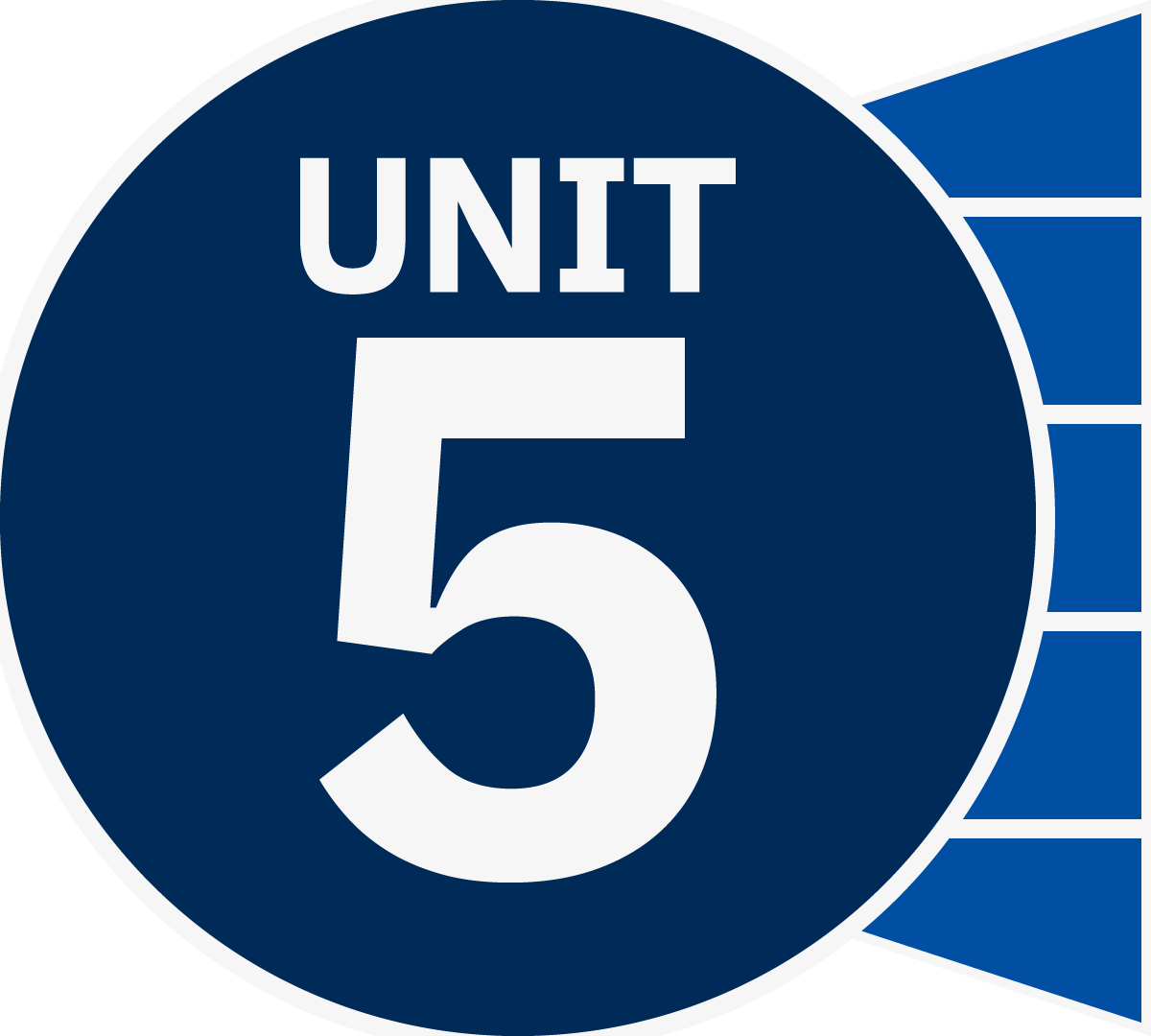Inquiry Companion: Unit 5
Unit 5 challenges students to trace the shifts in federal oversight as well as public opinion when it comes to civil liberties. Our Inquiry Companion Guide activities for Unit 5 facilitate student participation in inquiry-based civics learning for each strategy.
Students engage by considering the meaning of consent of the governed as well as explore primary source documents associated with landmark Fourth, Fifth and Sixth Amendment Supreme Court cases. They will explain the tension created by the intersection of Free Exercise Clause and the Establishment Clause by participating in a Paideia Seminar. Students then elaborate on their knowledge of the rights of the accused through a democratic experience simulation. Finally, students will evaluate their understanding of the Bill of Rights as they assess and defend each amendment.
Best practices for culturally responsive teaching weave through each activity.
Inquiry Guide Activity
- Unit 5, Lesson 31: How Do the Fourth and Fifth Amendments Protect against Unreasonable Law Enforcement Procedures?
- Unit 5, Lesson 32: How Do the Fifth, Sixth, and Eighth Amendments Protect Rights within the Judicial System?
- Unit 5, Lesson 27: How Does the Constitution Protect the Right to Due Process of Law?
- Active learning
- Collaboration
- Critical thinking
- Incorporating evidence
- Primary-source analysis
- Relationship skills
- Respect for others
- Identify and define amendments in the Bill of Rights.
- Analyze Supreme Court cases to assess the effectiveness of the language in the Bill of Rights.
- Amendment Update activity
- Does the Bill of Rights go far enough to protect my rights today?
- Primary source: Mapp v. Ohio or Mapp v. Ohio - Modified
- Primary source: Miranda v. Arizona or Miranda v. Arizona - Modified
- Primary source: Gideon v. Wainwright or Gideon v. Wainwright - Modified
- Strategy: Explore Constitutional Investigation Written Primary Source Analysis Tool
- We the People: The Citizen & the Constitution textbook
- amendment A change or addition to the Constitution or other legal document.
- basic rights Fundamental rights such as life, liberty, and property.
- right A power or privilege to which one is justly entitled.
- precedent Previous court decisions upon which legal issues are decided
- indigent defendant A person who is accused of a crime but cannot afford a lawyer to defend them in court.
Note: This lesson contains material about crimes that some students might find offensive or potentially traumatizing. A culturally responsive classroom will provide a welcoming and safe environment where students feel comfortable discussing difficult topics. Ensure students feel comfortable sharing appropriate personal perspectives. Consider establishing classroom norms that encourage discussion.
The rights guaranteed by the Fourth, Fifth, and Sixth Amendments are crucial protections for individuals facing legal proceedings in the United States. The Fourth Amendment safeguards against unreasonable searches and seizures, ensuring that evidence obtained illegally cannot be used in court. The landmark Supreme Court case Mapp v. Ohio (1961) affirmed the exclusionary rule, which prohibits the use of illegally obtained evidence in state criminal trials, thereby upholding the integrity of the legal process. The Fifth Amendment protects against self-incrimination and ensures due process, exemplified by the landmark case Miranda v. Arizona (1966), which established the requirement for police to inform suspects of their basic rights upon arrest, famously known as the Miranda rights. The Sixth Amendment guarantees the right to a lawyer, as demonstrated in the landmark case Gideon v. Wainwright (1963), where the Supreme Court ruled that states must provide a lawyer to defendants who could not afford one, ensuring adequate representation and a fair trial for all. These landmark court cases underscore the fundamental importance of upholding constitutional rights in the legal system. They serve as protections against government overreach, ensuring that individuals are safeguarded against unjust actions by law enforcement and guaranteeing fair treatment throughout the judicial process.
Additional resources for teacher background include:
- Mapp v. Ohio (Video)
- The Exclusionary Rule (Video)
- Miranda Rights (Video)
- What is the Miranda Rule and what are its purposes?-L31S6 (Video)
- Gideon v. Wainwright | Homework Help from the Bill of Rights Institute (Video)
Teachers should preview all student materials and resources prior to the lesson.
- Welcome students to social studies.
- Introduce the inquiry question: “Does the Bill of Rights go far enough to protect my rights today?”
- Allow students time to make a prediction about the inquiry question and offer their supporting questions.
- Using your routine strategy for setting up groups, divide the class into collaborative groups of approximately three to four student members. Each group will be assigned one of the following primary source investigations:
- Primary source: Mapp v. Ohio
- Primary source: Miranda v. Arizona
- Primary source: Gideon v. Wainwright
- For emerging readers, modified readings for the primary source documents are provided:
- Primary source: Mapp v. Ohio - Modified
- Primary source: Miranda v. Arizona - Modified
- Primary source: Gideon v. Wainwright - Modified
- Tell students that they will embark on a constitutional investigation into the effectiveness of the language in the Bill of Rights.
- For the first read-through, instruct students to work as a team to conduct a close reading of their assigned text to form a basic understanding.
- Circulate around the room, encouraging each group, observing progress, and redirecting as needed.
- For the second read-through, students will annotate their assigned text to indicate important sections and identify unclear items.
- Review the Annotation Station at the beginning of each primary source document to ensure students understand how to annotate their sources.
- ❍ Circle words you don’t know, and take a moment to find the definition.
- Highlight in YELLOW phrases that confuse you. Use context clues to figure out their meaning.
- Highlight in RED examples of the dangers or restrictions faced by the individual.
- Highlight in GREEN examples of rights and freedoms enjoyed by the individual.
- ✩ Star the items that make you wonder and wish to explore further.
- Circulate around the room, encouraging each group, observing progress, and redirecting as needed.
- Encourage students to collaborate in small groups to answer each others’ questions about the text.
- Distribute the Strategy: Explore Constitutional Investigation Written Primary Source Analysis Tool and review expectations on completing the analysis.
- In small groups, students will complete the Strategy: Explore Constitutional Investigation Written Primary Source Analysis Tool for at least one of the exhibits in their assigned primary source set.
- Circulate around the room, encouraging each group, observing progress, and redirecting as needed.
- Facilitate a brief class discussion encouraging students to share their observations on each respective unheard perspective group by asking the following questions:
- Who was the unheard or marginalized voice in the original case?
- What was at the heart of each of these cases?
- Why do you think these cases made it to the Supreme Court?
- What has happened to the interpretation of amendments over time?
- Does the Bill of Rights go far enough to protect my rights today?
- Allow students to offer their supporting questions.













